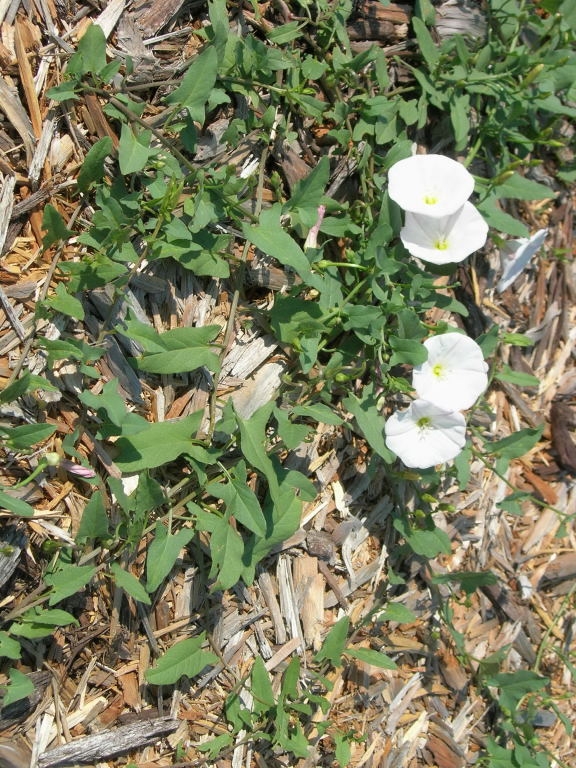Bindweed: a noxious weed

Field bindweed produces an almost delicate looking vine with arrow or shield-shaped leaves. It can be seen vining along the ground in gardens or the lawns. It can also be seen winding its way up fences and your favorite plant. Sometimes it is almost hidden until it burst into flowers. Bindweed has trumpet-like flowers that bloom in pink or white, resembling that of a small morning glory.
The vining weed is best known for its ability to multiply. Field bindweed is a non-native plant that spreads to smother or out-compete millions of acres of Kansas crops. Its spread did not stop in the country farm fields. Bindweed has adapted to city life and can be found in many lawns, gardens and landscape beds. In fact, in Kansas bindweed has been placed on the noxious weed list. A list that only includes the most damaging to crops and difficult to control
Bindweed can form tangled mats, run along the ground, twist and twine around other plants, plus climb up and over all kinds of things. Each plant can produce up to 500 seeds that remain viable for 50 years. But, bindweed’s real strength is underground, where the vine’s roots grow deep into the ground, while also extending out far enough to reach from one landscape into neighbors’ yards. A break in or bud on those lateral roots can produce another plant.
Bindweed control
This isn’t a weed you can control by hand pulling unless you’re willing to devote years or your entire life to the task. Trying to hoe it up simply helps bindweed spread. The recommended control in landscape beds and vegetable gardens has been glyphosate (Round-up type mixtures). Glyphosate is a nonselective herbicide that kills any green plant tissue it touches. When treating in shrub borders and gardens spray on a still day. It might be a good idea to put up a cardboard shield to protect the desirable plants from any drift. A word of caution, do not use glyphosate in a lawn as it will kill your grass.
Controlling bindweed in a lawn is a little easier as removing a broadleaf weed from a grassy lawn allows the use of more chemical options. Combination products containing 2, 4-D, dicamba and MCPP (Trimec) have proven to be effective as well as triclopyr. Another product on the market contains the active ingredient quinclorac. This product is often used in combination with other herbicides. Quinclorac is very stable and does not break down in grass clippings. So if you use this product do not catch the clippings for compost or mulch. It can also damage tree and shrub roots so avoid application within the dripline of any tree or shrub.
Organic control
Looking for an organic option to control bindweed? Well “good luck” is probably the best response, but solarization can be attempted by covering the area with clear plastic and letting it bake for two months during the heat of summer. This may reduce the amount but will not eradicate. Remember seeds can live for 50 years.
The best approach to combating bindweed is to stay ahead of its spread. The more it becomes established the harder it will be to control. So it goes without saying, repeated applications will be necessary. Best of luck with your battle in fighting this noxious weed as it is one the most difficult to kill.
Dennis Patton, Horticulture Agent
Have questions?
The Garden Hotline is staffed by trained EMG volunteers and Extension staff who will assist you with questions.
Phone: (913) 715-7050
Email: garden.help@jocogov.org